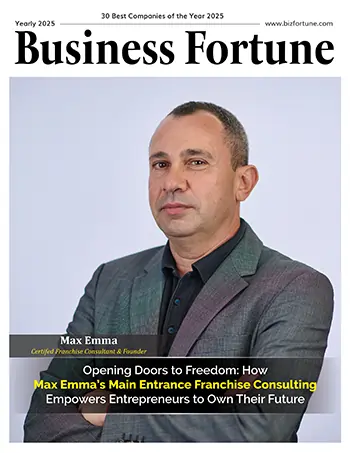Home Industry Gamification Gamification Apps: Boost Engag...
Gamification Apps: Boost Engagement & Productivity with Fun Tools
Gamification

Business Fortune
20 Febuary, 2025
App makers find it more difficult to differentiate themselves from rivals as mobile apps continue to dominate the market. People nowadays are prone to boredom, particularly millennials and Generation Z. As a result, they can only be continuously engaged by something challenging retention strategies.
Fortunately, businesses may stay competitive by using a variety of user engagement and retention strategies, such as social media management, in-product customer experiences, targeted discounts, freebies, etc.
Although you might not be aware of it, gamification apps are not limited to mobile apps; they can also be seen in everyday situations and the workplace (such as hiring). For example, educational apps might provide stickers to their pupils as a reward. Depending on how much a consumer spends, certain stores may offer them a set number of stickers, which they may then swap for a product that is being pushed. Some grocery store employees are eligible to enter a prize-giving contest. These retention strategies motivate students to complete assignments and customers to visit this particular business to enter a contest. In the actual world, gamification apps operate in this manner. Additionally, an increasing number of applications nowadays seek mobile app gamification.
What are Gamification Apps?
To boost user engagement, gamification apps introduce game-like features—like points, leaderboards, challenges, and rewards—into non-gaming environments. Developers may use users' innate drive for competition and success by incorporating these gamification elements, which will improve retention strategies and user loyalty.
The Science behind Mobile App Gamification
This gamification app’s efficacy stems from behavioral psychology. Rewards, progress monitoring, and social rivalry all serve as motivators for people and promote ongoing engagement. An effective gamification strategy may influence user behavior by adding excitement and fulfillment to even the most boring jobs.
Gamification in Fintech Apps
A lot of professionals have trouble focusing and managing their time. Gamification features are used by productivity gaming apps such as Habitica, Forest, and Todoist to assist users in setting objectives, finishing chores, and maintaining motivation. These applications make mundane work interesting and productive by transforming everyday activities into challenges and rewarding success.
An example of one such fintech app is Mint. Mint is a fintech app that uses a subscription manager based model to help you track your budget allowing you to reach your financial goals easily. Mint can also be considered a gamification app since it uses various gamification features and gamification strategies to keep its users hooked.
Gamification in Healthcare Apps
Healthcare apps use gamification strategies to increase user engagement, especially those that relate to mental and physical well-being. To motivate users to keep active, apps like Nike Run Club, Fitbit, and MyFitnessPal offer milestone incentives, social leaderboards, and challenges. Progress monitoring and streaks are used as incentive elements in meditation applications such as Headspace.
MySugr is another healthcare app for people suffering from diabetes. Patients can keep track of their eating habits as well as sugar levels. Though this may seem boring, MySugr adds all the important mobile app gamification elements such as a rewards system through progress tracking, making it an amazing consumer experience.
Gamification in E-Learning Apps
Platforms for education are leading the way in gamification. To promote consistent learning, e-learning apps such as Duolingo, Coursera, and Khan Academy include challenges, streaks, and point systems. To improve learning experiences and retention strategies, these applications use a variety of gamification strategies in the design of certain courses, such as interactive tests, virtual incentives, and social competition.
Codeacademy is one such platform that teaches development and coding. In 2018, they also joined the mobile app gamification revolution and released a new app called Codeacademy Go. The following components are used by the platform to gamify the app: Badges are given for completing particular skill levels. There are now four different kinds of badges: promotion badges, courses, exercises, and particular courses. The progress dashboard displays the lessons that have been finished as well as the ones that are coming up, and each completed activity earns points.
Gamification in Productivity Apps
Productivity apps enable us to live more effectively and gamify our everyday tasks. These applications remind us of the crucial activities we often put off by using gamification. These reminders are designed such that they are an invitation to finish a task rather than an annoyance. A few instances of mobile app gamification in productivity apps will now be discussed.
Forest is a productivity app that is also a gamification app now. It uses key gamification features to help you stay focused without being distracted by any social media platforms. While working on a task, you simultaneously plant a seed that grows into a tree. If the users fail to complete their task, the tree dies.
Key Gamification Features Driving Engagement
Common elements of successful gamification apps keep users interested and inspired:
- Points & Rewards: When users do activities, they receive points that may be exchanged for incentives.
- Leaderboards: Ranking systems promote ongoing participation and competitiveness.
- Challenges & Quests: Both immediate and long-term difficulties keep users engaged.
- Progress tracking: Users are inspired to reach their objectives by visual progress indicators.
- Social Features: User involvement is improved by integration with social media or community components.
These components may be put into practice using specialist gamification software. Google Game Services, Apple's Game Center, and Amazon GameCircle are a few examples.
A good gamification app requires more than simply design and programming, though. Its primary objective is to increase user engagement and retention, which may be accomplished with a simple incentive system and a few features.
Future of Gamification Apps
Gamification apps will keep developing. Blockchain technology, virtual reality, and artificial intelligence are some of the emerging developments that will further transform the gamification environment. Apps will be able to customize challenges and rewards for each user thanks to AI-powered customization, increasing user engagement and retention. Learning, fitness, and productivity chores will become more interesting with the help of virtual reality's more immersive and interactive experiences. Furthermore, decentralized incentive systems may be introduced with blockchain integration, guaranteeing security and transparency in gamified apps. Companies that successfully take advantage of these developments in mobile app gamification will have a competitive advantage thanks to improved retention tactics and more user engagement. Blockchain technology, virtual reality, and artificial intelligence will all improve the gamification of smartphone apps. Gamification elements will boost customer pleasure, engagement, and retention strategies for businesses that employ them well.
Conclusion
By making routine jobs more interesting and fulfilling, gamification apps are revolutionizing a variety of businesses. Incorporating a robust gamification strategy into e-learning apps, fintech apps, productivity game apps, or healthcare apps may greatly improve user experience and retention strategies. Businesses may achieve unprecedented success in the digital realm by combining utility with gaming elements in an ideal way.


































